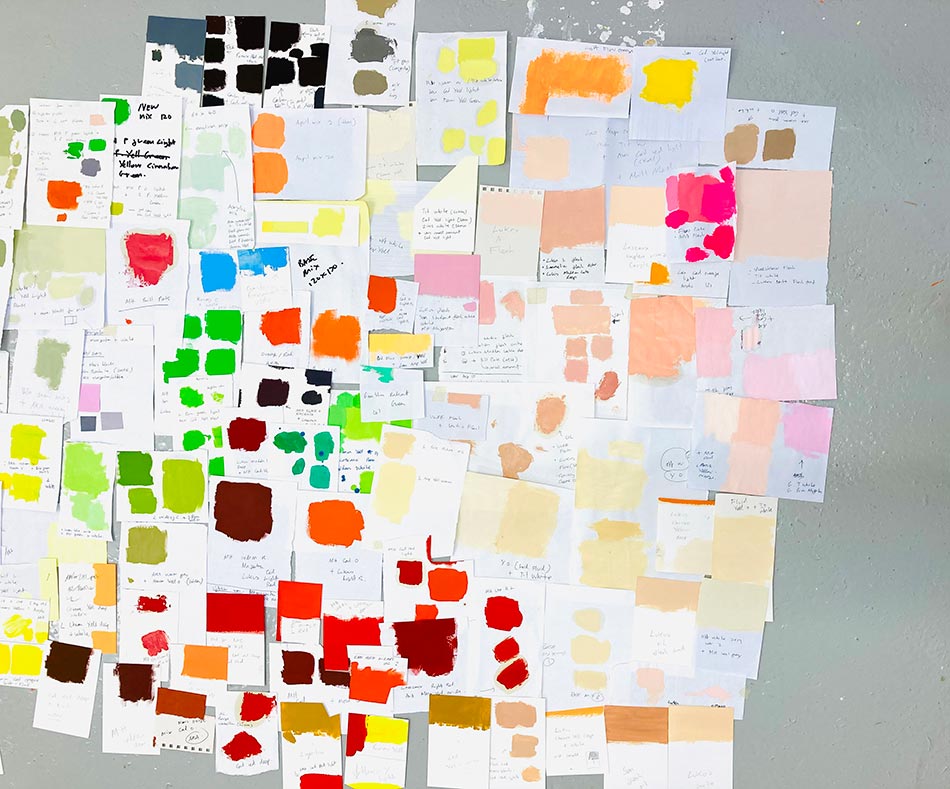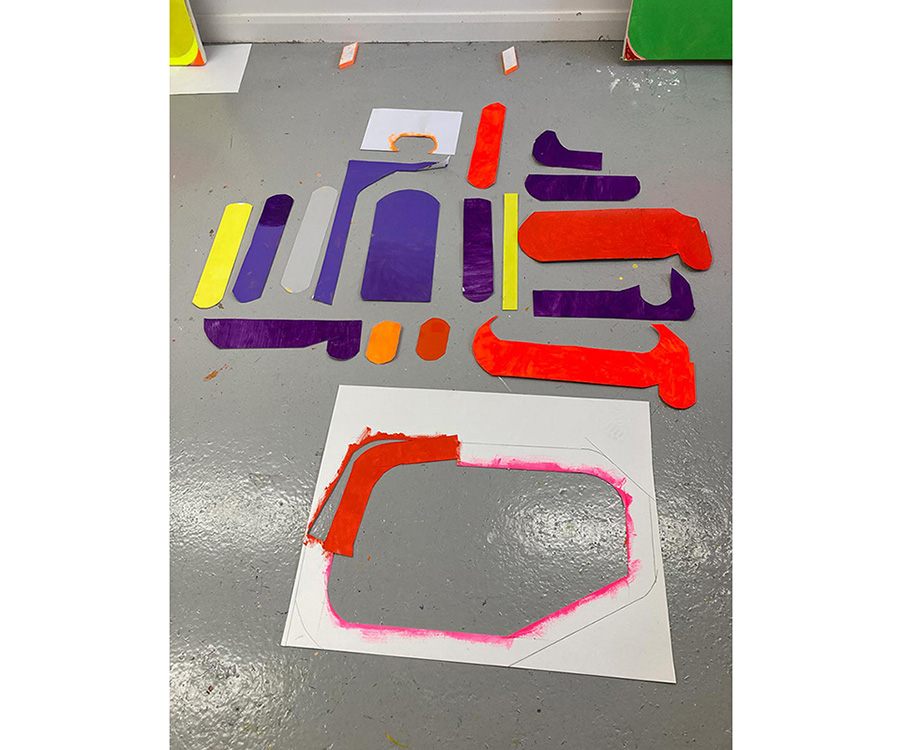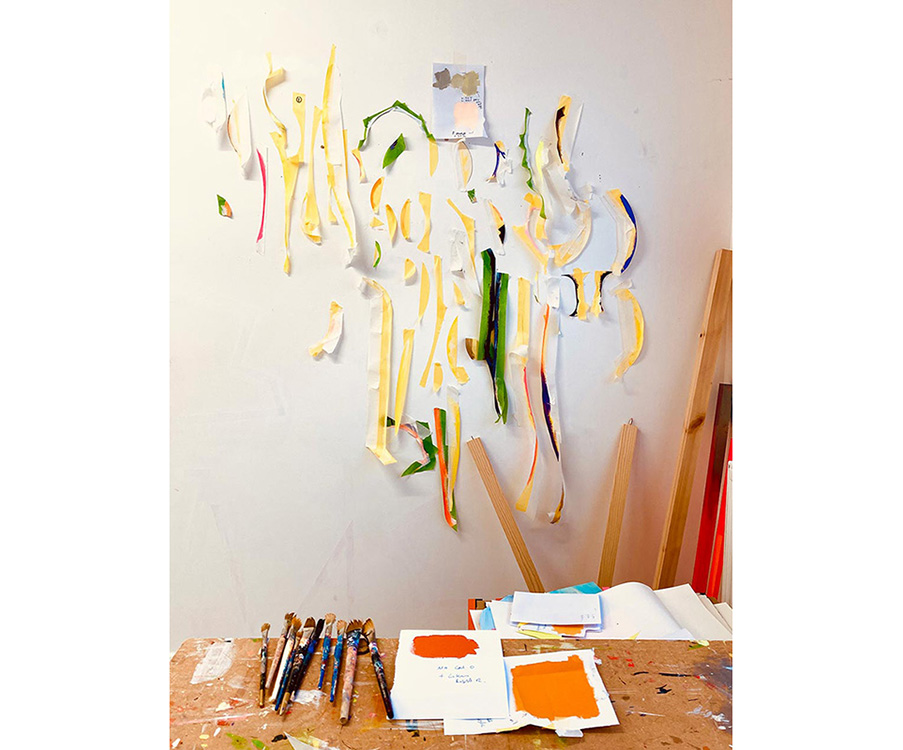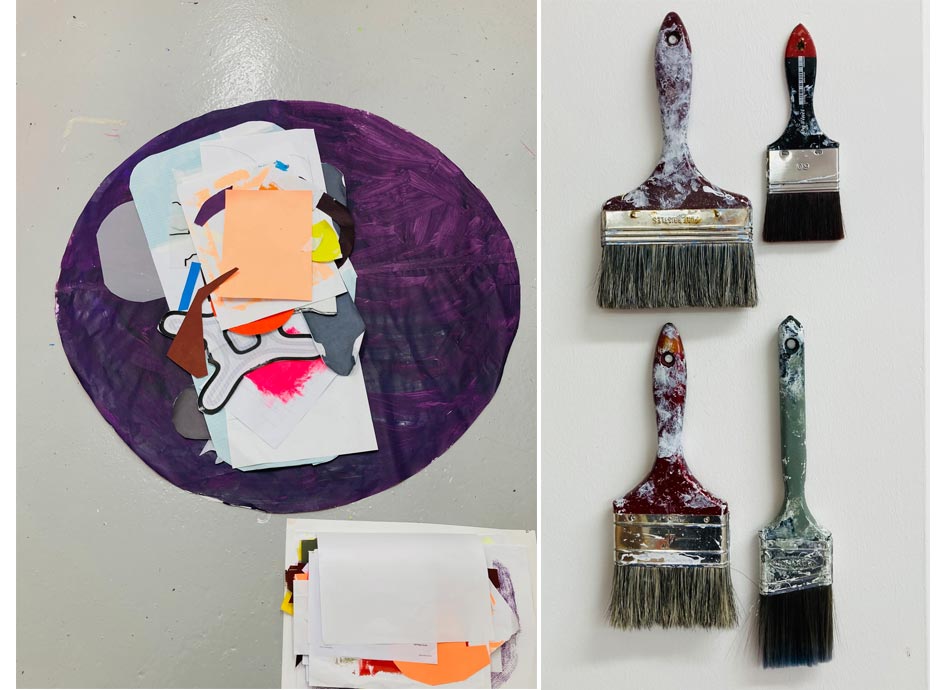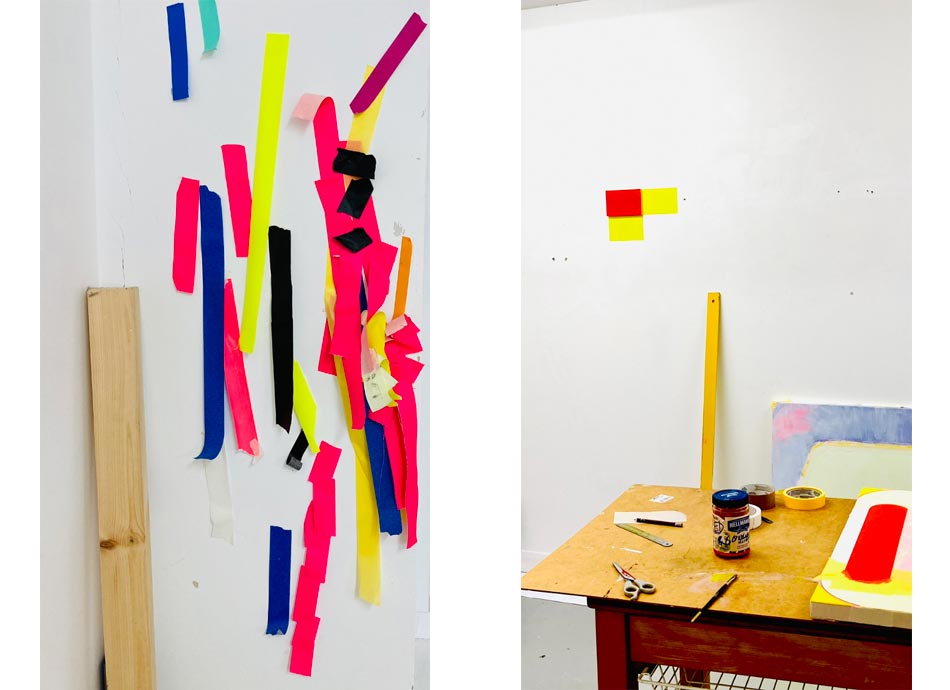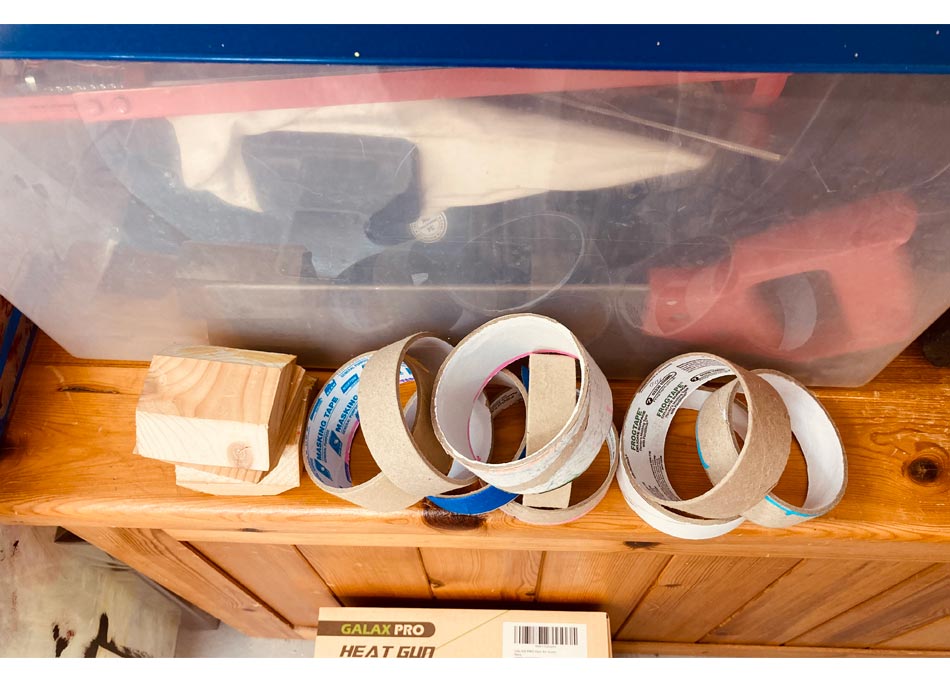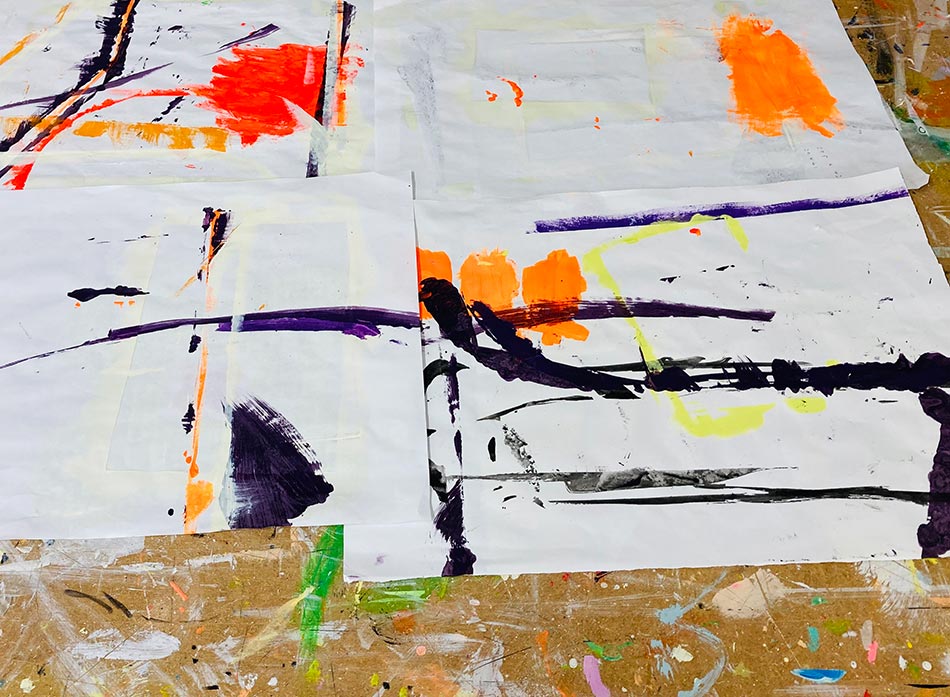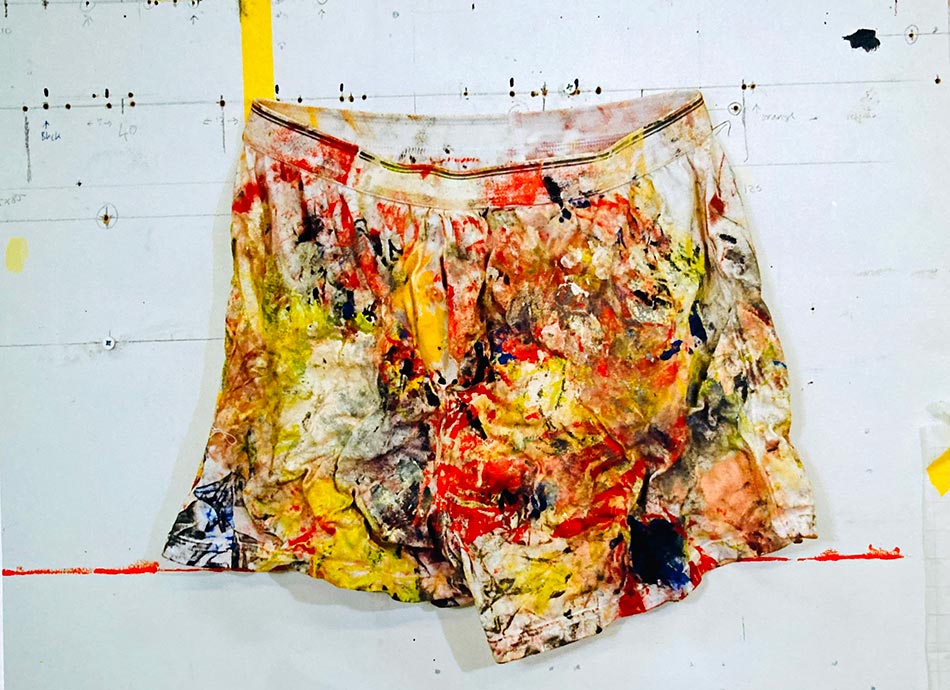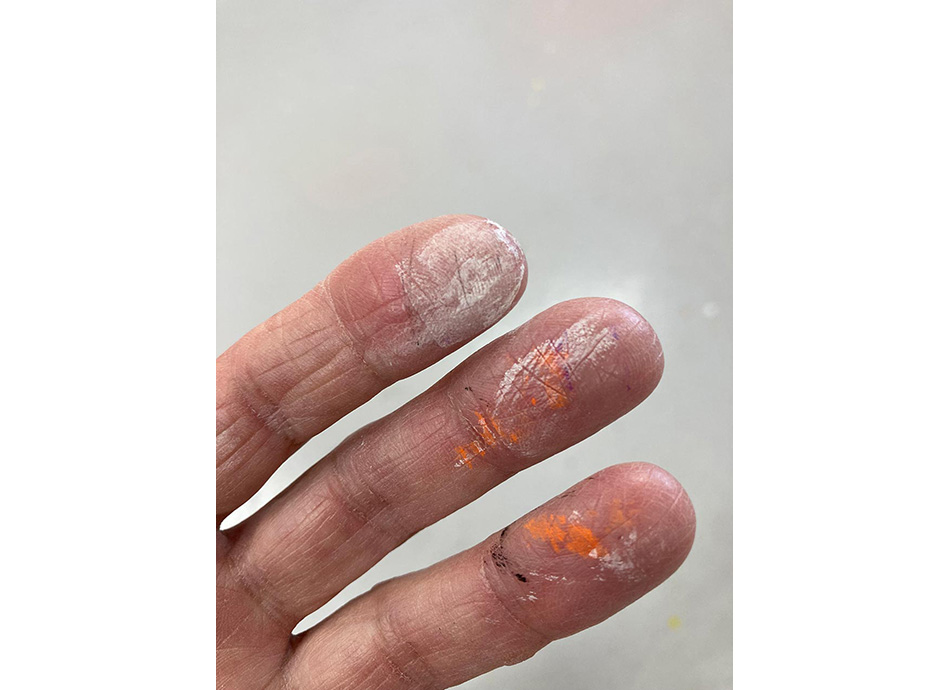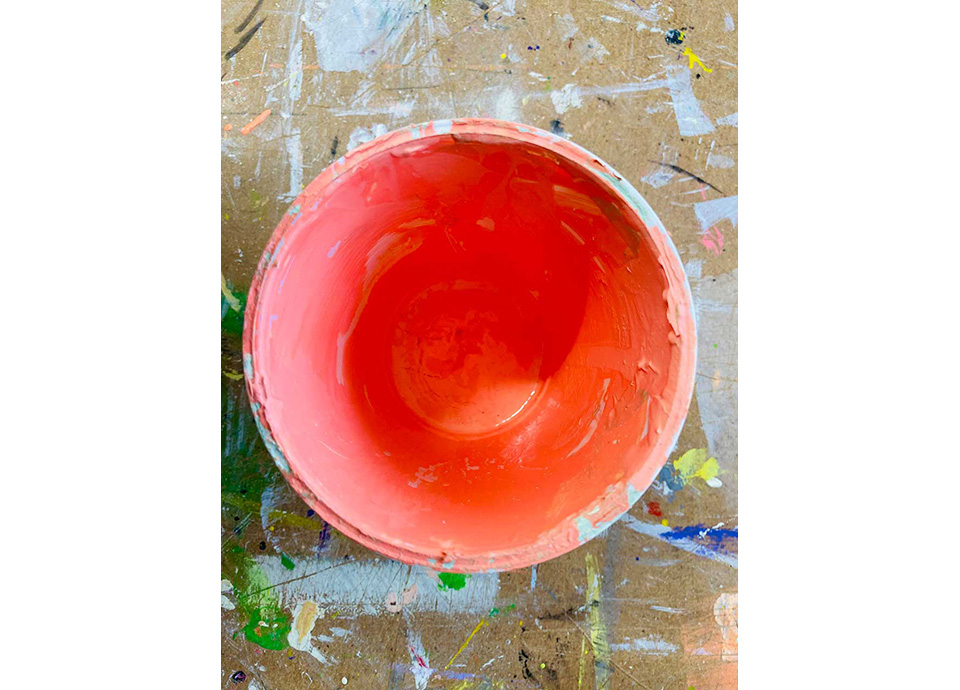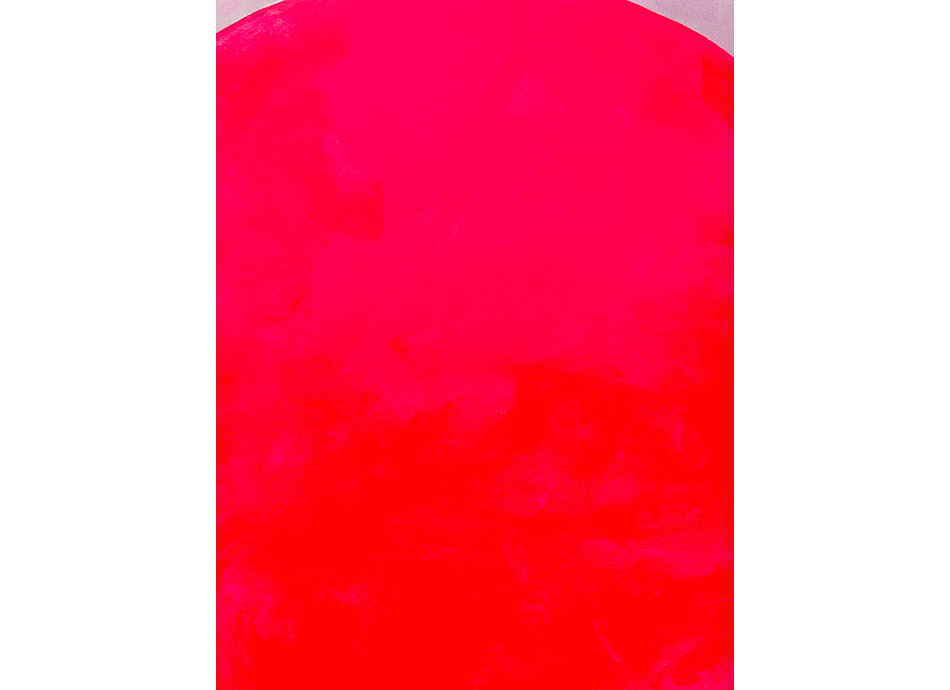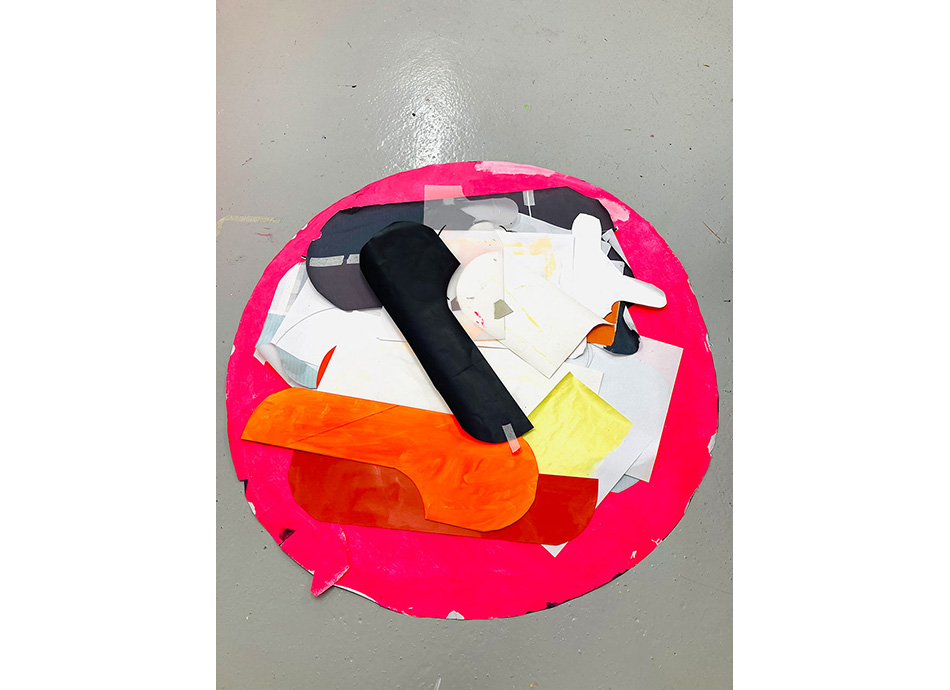“Material presence, physicality and the trace of the body are integral”.
Sandra Crisp LG: Oil as well as acrylic paint, wax crayon and marker pen on various supports such as linen, notebook paper, and cotton duck are just a few of the diverse materials used in your practice. Wall drawings and sometimes the addition of stenciled lettering to works such as ‘Oak Tree’ as well as blurry collaged imagery accompany a minimalist exploration of form, and colour. Paintings reveal intriguing traces of layers that existed before, sometimes standing out in slight relief and overall appearing to have been worked over long periods of time. Bold, yet subtle and fairly flat applications of bright colour, sometimes fluorescent are often contrasted by muted or monochrome hues.
In a recent social media post you mention certain works originating from ‘something outside the material practice of painting’. Whilst at other times ‘through the materiality of the medium’ – further insight into your working process and materials will be very interesting to hear.
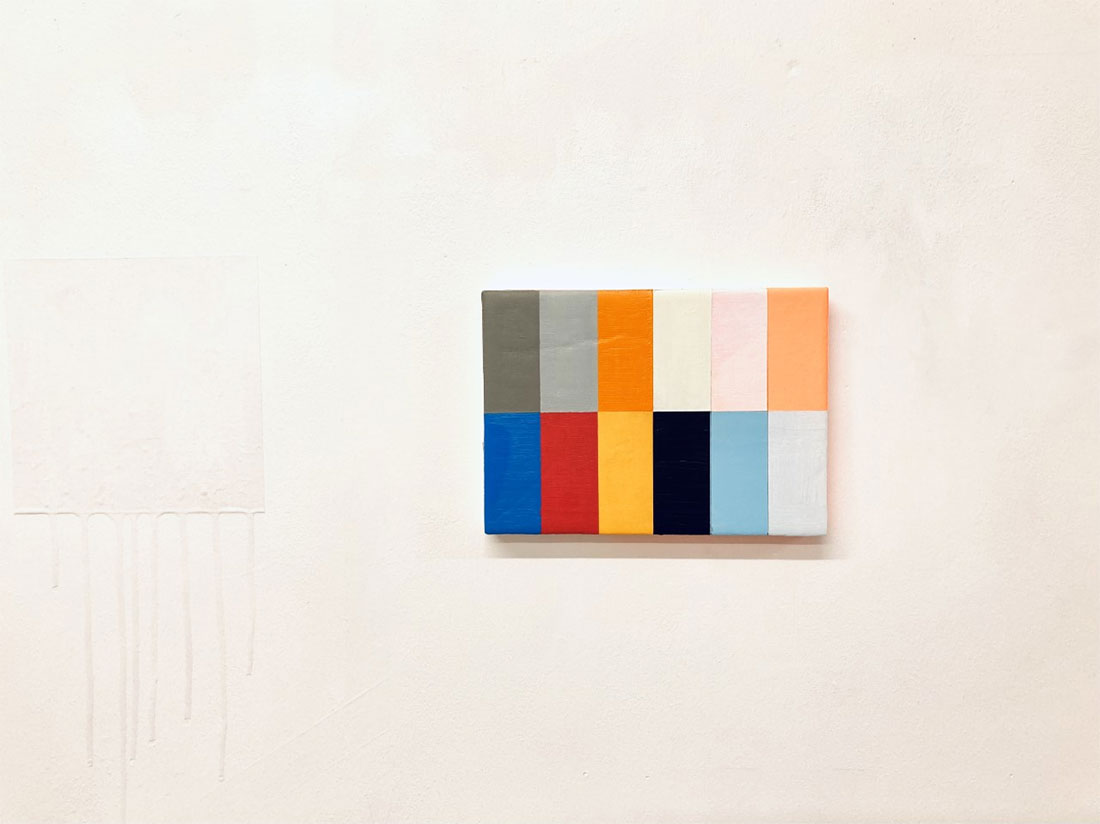
Thank you for the opportunity to reflect on ideas of process. There is of course the mundane stuff; what kind of paint, how do you mix it, what kind of support, how do you apply it? The kind of thing that painters spend a lot of time thinking about (at least I do), but which is very boring really. I remember a scene in the 1961 Tony Hancock film, The Rebel, where the ‘proper artist’ he shares a Paris studio with asks him how he mixes his paint. Hancock looks at him incredulously and replies, ‘in a bucket with a big stick’. It is of course a piss take of the whole Abstract Expressionism thing but it is also perhaps a kind of unintentional insider joke. As a young artist when I first saw that film on the TV, probably on a Sunday afternoon, it was also funny because I did mix paint in a bucket with a big stick! And I mixed everything from sand to tomato soup into it as well.
In whatever form it takes my work is grounded in the material practice of painting, the modernist notion of painting as matter, its status and process as material. This practice can be fractured and dispersed in terms of content and process and at times, painting, in an expanded sense, has embraced other means, including the photographic and filmic.
A work may start with a specific idea or as a vague reaction; a response to a thought, a feeling, a shape, diagrams or map colour keys, found photographic imagery, screen grabs, studio paraphernalia, everyday domestic objects, observational drawings, a piece of information. This might be emotional, political, aesthetic, material or intellectual and mostly all these things together. And of course all this is filtered into and through the ‘language’ – received, learnt, remembered, questioned, discarded and found again. And always the thing itself as it unfolds through the act of making. An accretion, a kind of muscle memory, from years of looking and trying to make things.
Material presence, physicality and the trace of the body are integral. The kind of support, scale, paint application, surface, accumulation of layers, obliterations, edges, densities (and the rest) are all things that self-evidently make the works what they are. There are shifting, internalised objectives which may be provisionally contextualised and have a methodology embedded in process. In epistemological terms this process is by education and instinct procedural rather than propositional, with all the attendant uncertainties, indeterminacy, latitude and internal logic, which exist in a studio practice. It can allow for the tangential to become the focus and process to drive the idea.
Sources can be subject to chance manipulation, through drawing, collage, tracing, projecting and at times the use of digital technology, which are then transcribed through the act of painting. Practice as a form of re-presentation, of traces – what else is there? A means of bringing extrinsic material into the arena of painting, however obliquely, and without an overly defining narrative.
Edge: Cut, taped, drawn, precise, imprecise, penetrated, vague, lost, moved, broken, erased, resistant, perimeter, border….
Shape: ‘And in trimming, adjusting, editing, messing around with shapes, one works not only from the individual expressive body, but with body politics—a politics that, like shapes, includes everything: our ambiguities, our dysphoria, our skin tones, our histories and consciousnesses, all the uncertainties, dangers, ugliness, eroticism, absence—the nights, fogs, dreams, and depth perceptions of our rhythms, losses, laments, and even our senses of humour, as we approach a kind of limit condition at the dead end of seriousness.’ The OG (#14) Zine produced in collaboration with MOMA for the exhibition Artist’s Choice: Amy Sillman, The Shape of Shape, 2020 MoMA
Surface: Flat, opaque, transparent, reflective, distressed, smooth, as a boundary, division and demarcation, an accretion, layers, one after the other, frontal, tilted, as a depth….
Stencil: Letters, words as marks, as referents. I made a painting towards the end of 2020. The stenciled words were derived from words found in conspiracy theories. The process of slowly stenciling the letters, running them into each other and waiting for each one to dry, like an accretion of madness.
Drawing: ‘It’s not paint. We all know that with paint you put down a pink, a red, a blue, a shape and you scumble it over, you change it. There’s a lot of funny business going on in painting. But drawing is direct.’ Philip Guston, On Drawing, 1974. (Philip Guston, I Paint What I Want to See. Penguin Books London, 2022)
Paint: These days I use more acrylic than oil. I keep the water I wash the brushes with in five litre containers to then dispose of it, without it going into the sewage system. I’ve loads of five litre containers full of discoloured water. I think they are perhaps a painting. Over the years I have accumulated various brands of oil paint called ‘flesh’ colour or tint or some such. They are all some kind of pink!
Colour: In Chromophobia David Batchelor argues ‘that colour has been the object of extreme prejudice in Western culture.’ He writes of attempts to devalue and diminish its significance and deny its complexity. ‘this purging of colour is usually accomplished in one of two ways. In the first, colour is made out to be the property of some ‘foreign’ body – usually the feminine, the oriental, the primitive, the infantile, the vulgar, the queer or the pathological. In the second, colour is relegated to the realm of the superficial, the supplementary, the inessential or the cosmetic. In one, colour is regarded as alien and therefore dangerous; in the other, it is perceived merely as a secondary quality of experience, and thus unworthy of serious consideration.’ David Batchelor, Chromophobia, London: Reaktion, 2000
Studio: Works made in and sometimes about that space. The external world, the political and personal streaming into that space. Environmental degradation, the view from the window of an oak tree, popularism, a discarded piece of card on the floor, pointless imperial wars, something to draw around, the ugly old tropes of fascism, a voice on the radio. All a kind of endless incoherence and the human things too, love and memory. The studio, a place where all this is inadequately processed through the absurd but entirely necessary act of making something.
Wall: Because it’s temporary!
.
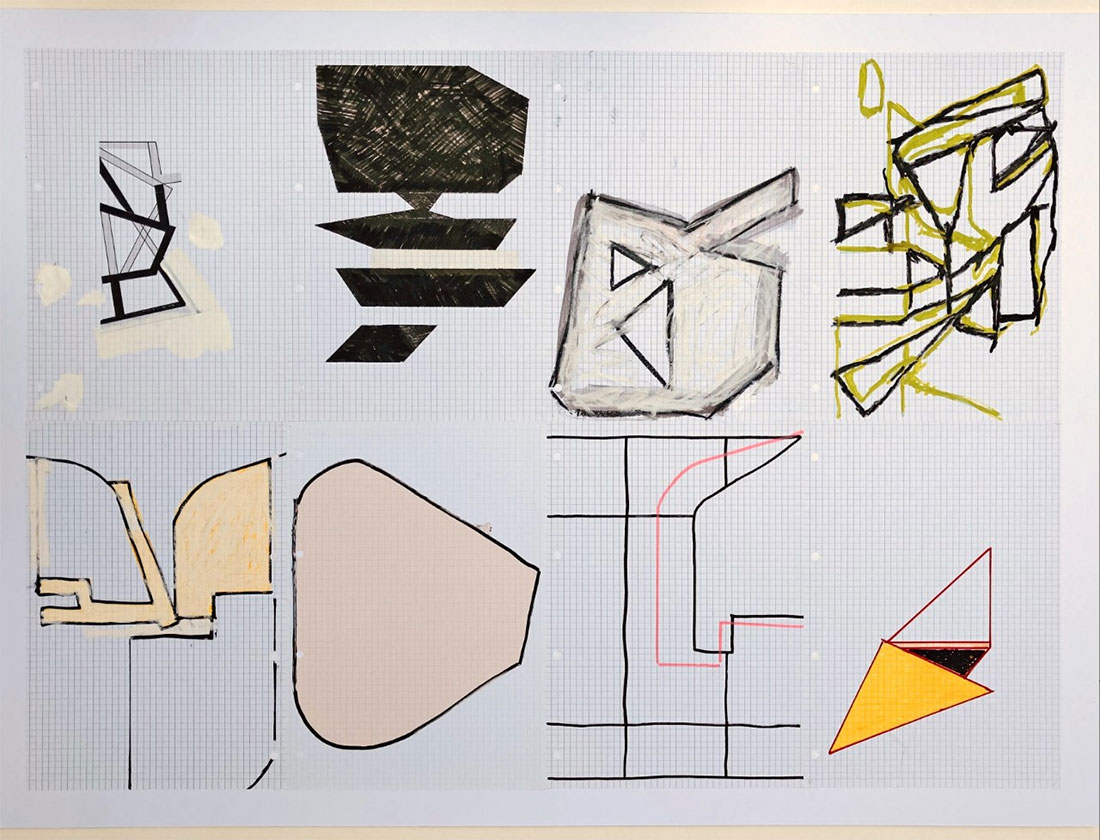
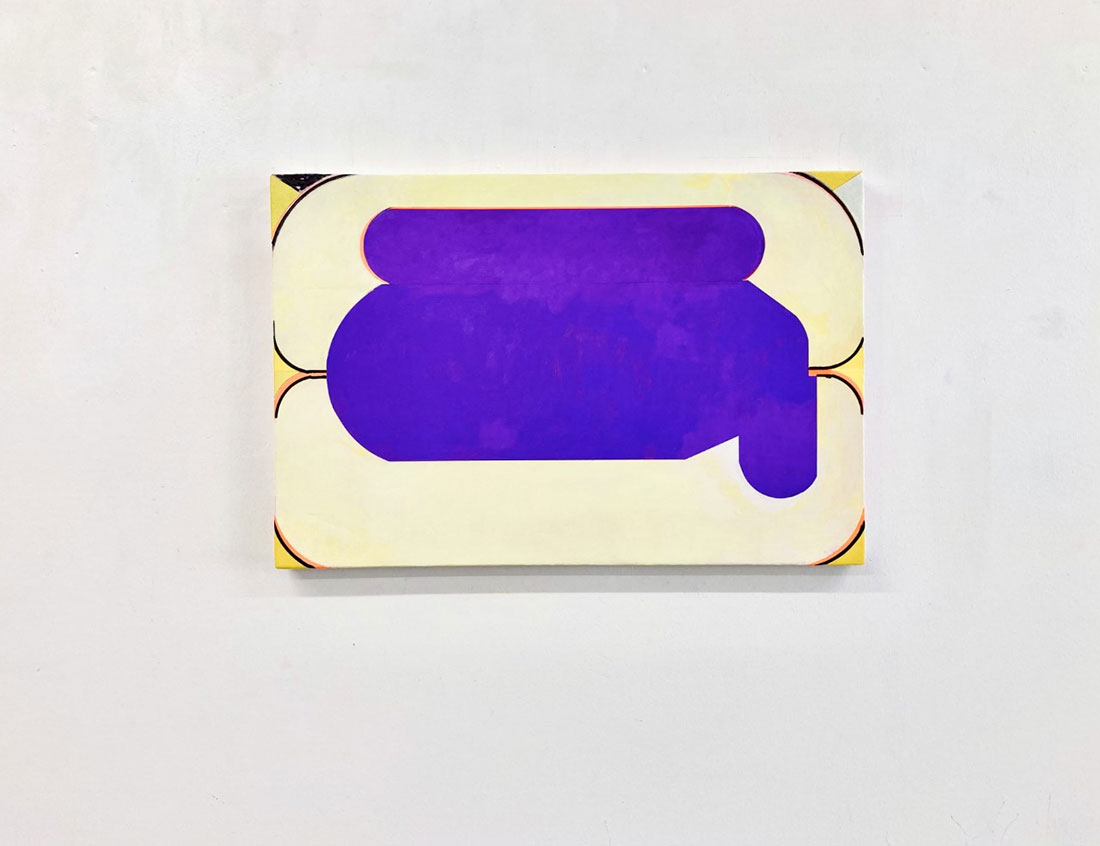
Ian Parker LG, 2022
Website: ianparker.org.uk
Instagram: @iparkermurl
Current and Forthcoming Exhibitions:
> see Parker’s latest work in THE GALLERY
> Work included in The Trinity Buoy Wharf Drawing Prize 2022. Initially at Trinity Buoy Wharf, Sept-Oct 2022, currently at Willis Museum and Sainsbury Gallery, Basingstoke, Hampshire, UK 26 Oct 2022-22 Jan 2023, then, ArtHouse Jersey, 9 Feb – 26 Mar 2023.

